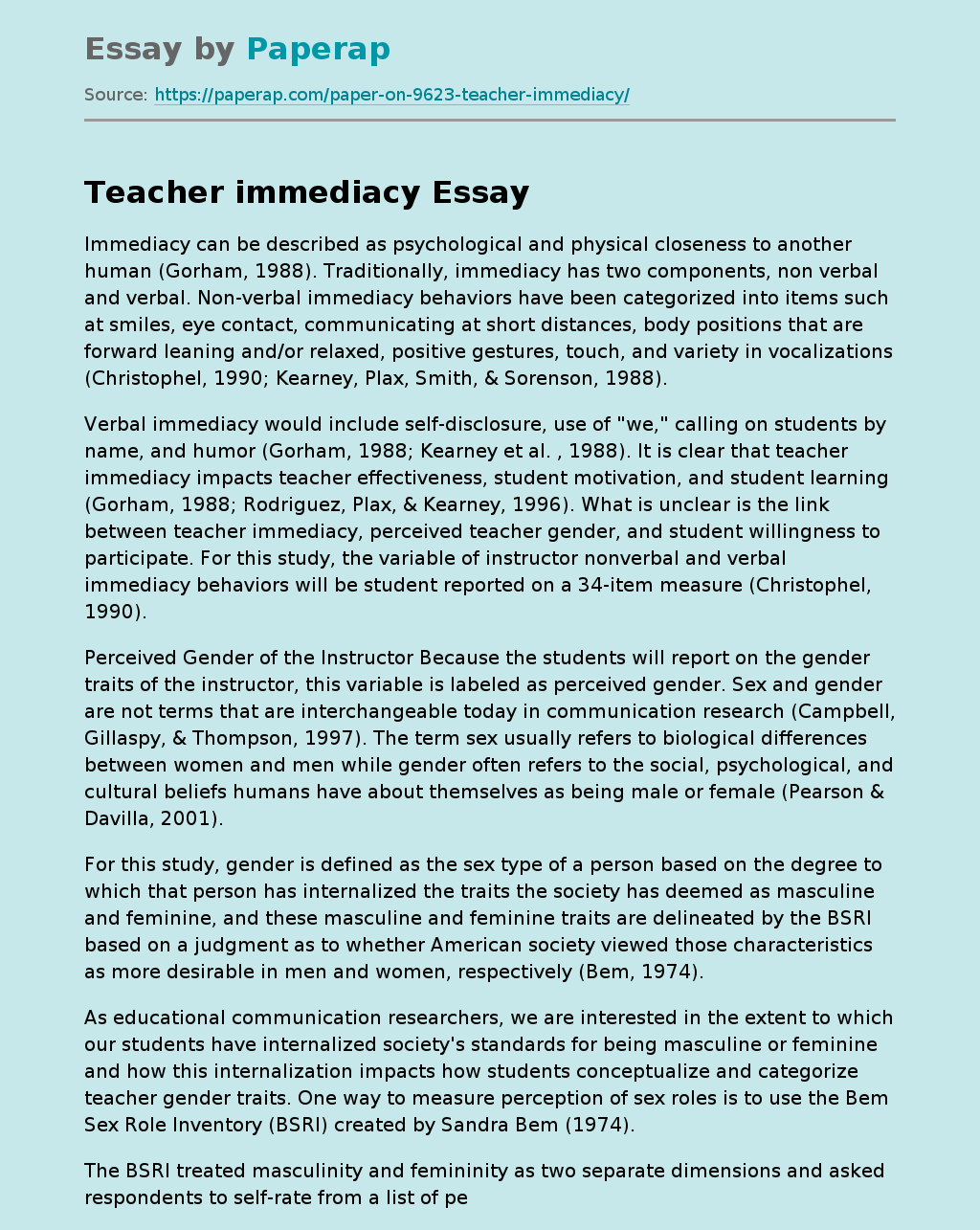Perceived Gender of the Instructor
Immediacy can be described as psychological and physical closeness to another human (Gorham, 1988). Traditionally, immediacy has two components, non verbal and verbal. Non-verbal immediacy behaviors have been categorized into items such at smiles, eye contact, communicating at short distances, body positions that are forward leaning and/or relaxed, positive gestures, touch, and variety in vocalizations (Christophel, 1990; Kearney, Plax, Smith, & Sorenson, 1988).
Verbal immediacy would include self-disclosure, use of “we,” calling on students by name, and humor (Gorham, 1988; Kearney et al. , 1988). It is clear that teacher immediacy impacts teacher effectiveness, student motivation, and student learning (Gorham, 1988; Rodriguez, Plax, & Kearney, 1996).
What is unclear is the link between teacher immediacy, perceived teacher gender, and student willingness to participate. For this study, the variable of instructor nonverbal and verbal immediacy behaviors will be student reported on a 34-item measure (Christophel, 1990).
Because the students will report on the gender traits of the instructor, this variable is labeled as perceived gender. Sex and gender are not terms that are interchangeable today in communication research (Campbell, Gillaspy, & Thompson, 1997).
The term sex usually refers to biological differences between women and men while gender often refers to the social, psychological, and cultural beliefs humans have about themselves as being male or female (Pearson & Davilla, 2001).
For this study, gender is defined as the sex type of a person based on the degree to which that person has internalized the traits the society has deemed as masculine and feminine, and these masculine and feminine traits are delineated by the BSRI based on a judgment as to whether American society viewed those characteristics as more desirable in men and women, respectively (Bem, 1974).
As educational communication researchers, we are interested in the extent to which our students have internalized society’s standards for being masculine or feminine and how this internalization impacts how students conceptualize and categorize teacher gender traits. One way to measure perception of sex roles is to use the Bem Sex Role Inventory (BSRI) created by Sandra Bem (1974).
The BSRI treated masculinity and femininity as two separate dimensions and asked respondents to self-rate from a list of personality traits (Auster & Ohm, 2000). Each respondent would be classified into one of four groups: androgynous (high masculine/high feminine), masculine (high masculine/low feminine), feminine (low masculine/high feminine), and undifferentiated (low masculine/low feminine) (Pearson & Davilla, 2001; Wheeless, & Dierks-Stewart, 1981).
In the original study, Menzel and Carrel (1999) found no significant relationship between the biological sex of instructors and student willingness to participate. What is unclear is both the relationship between perceived teacher gender and student willingness to participate and the relationship between perceived teacher gender and teacher immediacy behaviors. For this study, the variable of perceived gender of the instructor will be student reported on a 20-item BSRI. Willingness to Talk
Student willingness to talk is an important component of the classroom environment, but unfortunately it is rare for the majority of students participate in whole class discussion (Green, 2000) Oral student participation is linked to active learning (Steinert, & Snell, 1999), and instructors use class discussions to develop critical thinking skills (Garside, 1996) and to improve student communication competence (Zorn, 1991). Furthermore, student in-class speech is often a way that teachers gauge their pedagogical effectiveness, and instructors also use student speech to evaluate student learning (Cooper, 1995).
Despite the importance of student speech in student learning, in a discussion setting that incorporates thirty-five students or less, 15 percent of the students will be responsible for 75 percent of all student speech (Green, 2000). Because of this disparity in student participation, it is important to study variables that could influence student willingness to speak. Menzel and Carrel (1999) found the level of student willingness to talk to be positively correlated with student learning; they also argued that classroom dialogue is important to study because it is a reflection of effective instruction.
When measuring willingness to talk in class, it seems reasonable to accept Menzel and Carrel’s (1999) incorporation of the variables of student interest and state motivation, type of participation environment, seating arrangement, and level of discord with ideas discussed, especially since the researchers statistically evaluated their instrument for internal validity and found these variables valuable in studying student willingness to talk.
For this study the variable of student willingness to talk in class is self-reported on a 19-item measure incorporating the aforementioned variables (Menzel & Carrel, 1999). Purposes and Objectives This study seeks to replicate portions of the original study done by Menzel and Carrell (1999), with biological sex being replaced by gender of instructor, which is defined as psychological gender traits and student reported on the shortened BSRI. As previously discussed, research has positively correlated teacher immediacy behaviors with student willingness to talk (Menzel & Carrell, 1999).
Previous research has not investigated two potential relationships: between student willingness to talk and perceived instructor gender traits, and between instructor immediacy behaviors and perceived instructor gender traits. Hypothesis and Research Questions: H1: A student’s willingness to talk in class will positively vary based on instructor immediacy behavior (verbal and nonverbal combined in one variable). RQ1: Will a student’s willingness to talk in class vary as a function of the student reported perceived gender of the instructor?
RQ2: Is there a relationship between instructor immediacy behavior (verbal and nonverbal combined in one variable) and student reported perceived gender of the instructor? With regard to our data set, we surveyed community college students while Menzel and Carrell (1999) surveyed university students. Given the differences between the educational plans of some community college students and the educational plans of university students, we wondered if length of planned education could impact how students reported on the three variables of our study. With this in mind, we posed a final research question.
Perceived Gender of the Instructor. (2017, Nov 28). Retrieved from https://paperap.com/paper-on-9623-teacher-immediacy/

